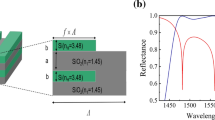Abstract
One main difference between practical device and ideal design for subwavelength grating structure is the tapered sidewall profile of grating, which is normally obtained by the practical CMOS-compatible fabrication and etching process. Our work has investigated the impacts of tapered sidewall profile on the subwavelength grating wideband reflector characteristics. Both zero-contrast gratings (ZCG) and high- contrast gratings (HCG) are numerically investigated in detail and the results show a distinct differences of the impacts of tapered sidewall profile of grating. The simulation results reveal that this factor play a critical role in determining the reflection bandwidth, average reflectance, and the band edge. Our study has potential in guiding the utilization of subwavelength grating wideband reflector on application of a variety of nanophotonic devices and their integration, as well as to facilitate the design of the fabrication process on the control of tapered sidewall profile.
Similar content being viewed by others
References
A.Hessel and A.A.Oliner,”A new theory of wood’s anomalies on optical gratings,”Appl. Opt. 4, 1275–1297 (1965).
R. Magnusson, “Wideband reflectors with zero-contrast gratings,” Opt. Lett. 39, 4337 (2014).
C.J.Chang-Hasnain and W.Yang,”High-contrast gratings for integrated optoelectronics,” Adv. Opt. Photonics 4, 379–440 (2012).
C. F. R. Mateus et al., “Ultra-broadband mirror using low index cladded subwavelength grating,” IEEE Photonics Technol. Lett. 16, 518 (2004).
Z. S. Liu et al., “High-efficiency guided-mode resonance filter,” Opt. Lett. 23, 1556–1558 (1998).
A. Szeghalmi, E. B. Kley, and M. Knez, “Theoretical and experimental analysis of the sensitivity of guided mode resonance sensors,” J. Phys. Chem. C 114, 21150–21157 (2010).
S. F. Lin et al., “A model for fast predicting and optimizing the sensitivity of surface-relief guided mode resonance sensors,” Sens. Actuators B 176, 1197–1203 (2013).
A. Y. Zhu, S. Zhu, and G. Q. Lo, “Guided mode resonance enabled ultra-compact germanium photodetector for 1.55 μm detection,” Opt. Express 22, 2247–2258 (2014).
A. V. Kabashin et al., “Plasmonic nanorod metamaterials for biosensing,” Nat. Mater. 8, 867–871 (2009).
Y. R. Lin et al., “Slope-tunable Si nanorod arrays with enhanced antireflection and self-cleaning properties,” Nanoscale 2, 2765–2768 (2010).
Y.Wangetal.,”Biomimetic corrugated silicon nano cone arrays for self-cleaning antireflec-tion coatings,” Nano Res. 3, 520–527 (2010).
J. Zhu, S. Liu, H. Jiang, C. Zhang, and X. Chen, Opt. Lett., 40, 471 (2015)
Author information
Authors and Affiliations
Corresponding author
Rights and permissions
About this article
Cite this article
Yu, W., Wu, D., Duan, X. et al. Subwavelength grating wideband reflectors with tapered sidewall profile. MRS Advances 1, 1683–1691 (2016). https://doi.org/10.1557/adv.2015.18
Published:
Issue Date:
DOI: https://doi.org/10.1557/adv.2015.18




